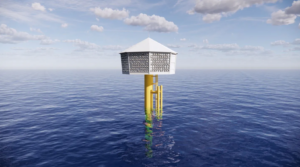
Charles J. Sharp, CC BY-SA 4.0, via Wikimedia Commons
We often hear the tales of noncaring and willful teardown of important habitat locations for birds to construct things meant for the critical needs of expansive human needs. With those, we run strong, sometimes overpowering risks that – sadly – challenge the long-term survivability of species of birds and others. It would be an extraordinary reality if those who invade habitats took into consideration the needs of helpless creatures. While that remains a large and often improbable task, a Danish company is responding to a requirement to help give possibilities to a threatened species of seabird known as the kittiwake.
Ørsted is a renewable energy company located in Denmark. Its main goal is to help our world transition to and become fully dependent on “green” energy. They construct and operate wind and solar farms, energy storage facilities, renewable hydrogen facilities, and bioenergy plants. Birds are susceptible to large structures like wind turbines, resulting in a high mortality rate for some bird species. A Biological Conservation 2013 study has estimated that a total of around 235,000 birds die annually due to the mass of large monopole wind turbines around the world. By now, that number is likely to be even higher as more structures are erected to advance wind energy collection.
Ocean Nests

The kittiwake bird is a species of the Gull family. These small white-bodied, gray-backed, and gray-winged birds are separated by two species known as black-legged in the U.K. areas they live in. (There is a red-legged species found in North America). They form densely packed colonies in their nesting arenas and are exclusive cliff-nesters. They are found in northern climes connected by the Pacific Ocean, the Atlantic Ocean, and the Arctic Ocean. The gulls are dependent on marine life for their diet.
A massive offshore wind farm is being constructed by Ørsted off the east coast of England. To complete the project, the company was compelled to construct three large artificial kittiwake nest structures on the ocean not far from the shores to help ease the decline of the species, something that has been noted since 2000. With all this in mind, the development of the close-to-shore nests will aid further in keeping them safer from predators.
The nests were designed specifically to cater to the needs of the kittiwake bird. They were created with help from ecologists and engineers. A single pile was driven in with an octagonal structure affixed on top. Each structure can house 500 nests in a complex arrangement supported by ledges. To help science monitor the birds within the structures, space has been saved for researchers, who can then maintain completely obscure observations. There are chairs, tables, and a whiteboard within the spaces for the researchers to use along with panels that allow the researchers to look at the population of birds, but the birds cannot see them. In addition, cameras were installed for the constant monitoring of the birds as they acclimate to make these structures their new nesting areas.

2 Comments